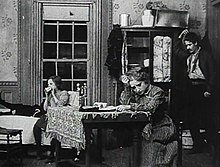A trap for Santa Claus
| Movie | |
|---|---|
| Original title | A trap for Santa Claus |
| Country of production | United States |
| original language | English |
| Publishing year | 1909 |
| length | 16 minutes |
| Rod | |
| Director | David Wark Griffith |
| script | David Wark Griffith |
| camera | GW Bitzer |
| occupation | |
| |
A Trap for Santa Claus , sometimes shortened A Trap for Santa , is an American film drama from director David Wark Griffith from the year 1909 . The film is a production by the Biograph Company .
action

Arthur Rogers is an unemployed , alcoholic husband and father of two who has no money for Christmas presents . A subheading describes the situation of the family: Misery and want, the family's lot ( German : misery and hardship: the lot of the family ). The wife Helen and her daughter cry because of her poverty . Arthur goes into the bar and asks the bartender to drop him a drink. The latter refuses, whereupon two guests invite Arthur to their table and buy him several drinks. Arthur returns home drunk to his desperate wife and daughter. The next scene begins with a subtitle: Helpless, the father leaves the house of sorrow (German: Helpless leaves the father's house of sorrow ). He writes a letter: Dear Helen, you will be better off without me. I leave for good. May God help you. Arthur (German: Dear Helen, you're better off without me. I'm going for your sake. God protect you. Arthur ). He slips the letter under the door and leaves his family. Helen takes the letter and reads it. Meanwhile Arthur goes to the bar, gets drunk to the point of unconsciousness and is thrown outside by the bartender. Helen and her daughter go to the employment office but are turned away. When they return, the little son has finished the last little piece of bread . His arm is in a loop that is not explained in detail.
A lawyer appears to Helen and informs her that she has inherited a fortune from her aunt . Helen and the children are over the moon. Helen is luxuriously dressed when she and her children are taken to their new home by the lawyer. The house is lavishly decorated and has a maid but no fireplace . So Helen tells the children on Christmas Eve that Santa Claus will come through the window. She puts the children to bed, but they sneak up to the window to set a trap for Santa Claus. The reason is not explained, but the children probably want to bring down Santa Claus to convince themselves of his existence. Helen has bought a Santa Claus costume and is looking forward to surprising her children in disguise to show them that Santa Claus really exists. As she thinks about it, she becomes sad to realize that a man - her husband - should be wearing the costume.
Helen doesn't know that her husband is now making a living as a burglar . He approaches the house, not knowing that his family now lives there, and climbs in through the window, but gets caught in the children's trap. Helen realizes that Arthur wanted to break into her and the children and is shocked, while Arthur is ashamed . Arthur asks his wife to be allowed to return and she agrees after much deliberation. Now Arthur in disguise plays Santa Claus and the family is reunited.
Recovery
A Trap for Santa Claus was first performed on December 20, 1909.
A fragment of the film poster was found in Zurich in summer 2009 during renovation work in the former Radium cinema . The find suggests a contemporary performance in this cinema and the exploitation in other European countries as well.
A Trap for Santa Claus is part of the Library of Congress's Paper Print Collection .
Technical details
The film is a one-reeler on 35 mm film with a length of 301 meters. It was recorded in full at Biograph Studios in Fort Lee , New Jersey .
Web links
- A Trap for Santa Claus in the Internet Movie Database (English)
Individual evidence
- ↑ Iris Barry : DW Griffith. American Film Master (= Museum of Modern Art Film Library Series . Volume 1). Museum of Modern Art, New York NY 1940 (reprinted there in 2002, ISBN 0-87070-683-7 ), p. 42.
- ↑ Adrian Gerber, Andreas Motschi: The poster Fund from the cinema radium in Zurich. Movie posters from 1907 to 1914 and other materials . Office for Urban Development, Zurich 2011, PDF, 28.4 MB , accessed on December 24, 2018.
- ↑ Kemp R. Niver : Motion Pictures from the Library of Congress Paper Print Collection, 1894-1912 . University of California Press, Berkeley 1967, OCLC 10912882 .
- ↑ Richard Koszarski: Fort Lee. The Film Town . John Libbey Publishing, East Barnet, Herts 2004, ISBN 0-86196-653-8 , p. 58.


